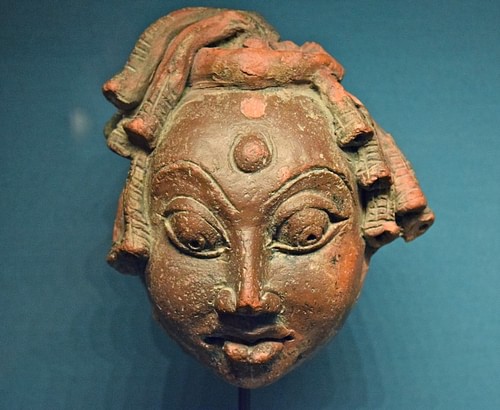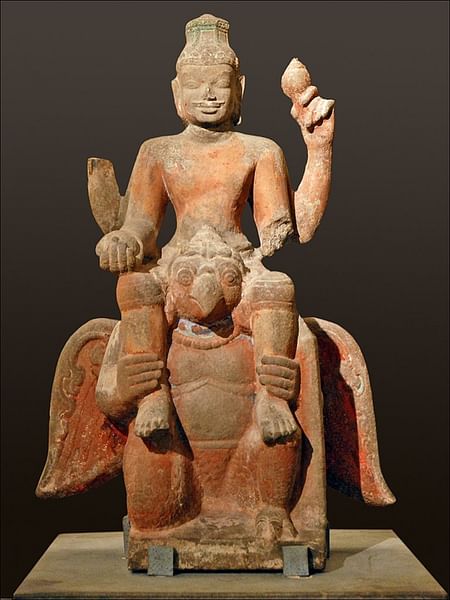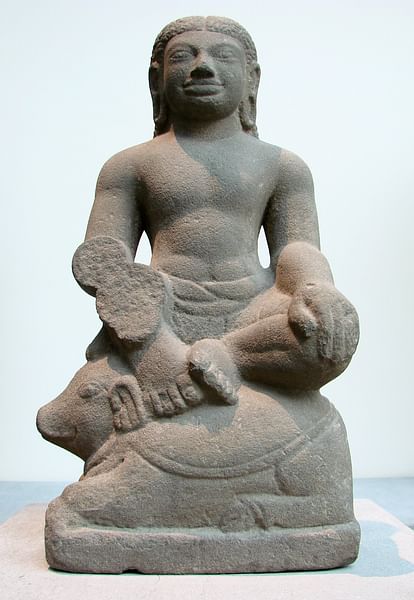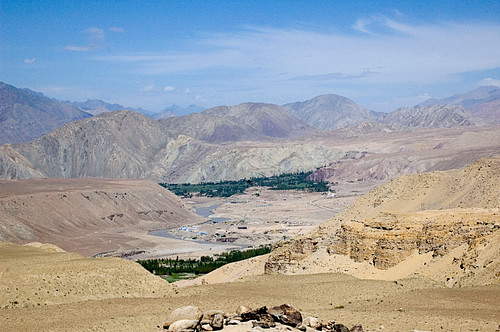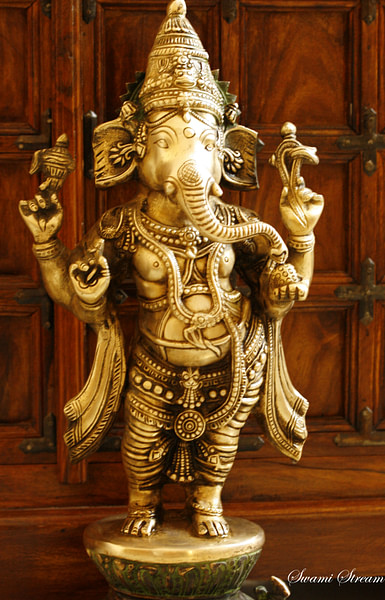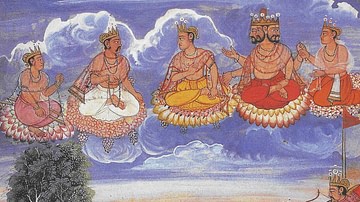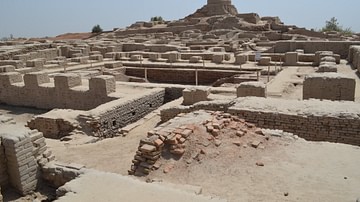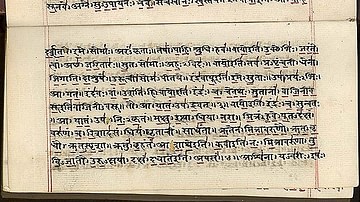The religious practices of the early Indo-Aryans, known as the Vedic religion (1500 BCE to 500 BCE) were written down and later redacted into the Samhitas, four canonical collections of hymns or mantras, called the Veda, in archaic Sanskrit.
The Late Vedic age (9th to 6th centuries BCE) marked the beginning of the Upanisadic or Vedantic phase. This epoch heralded the start of what became classical Hinduism, with the composition of the Upanishads, later the Sanskrit epics, still later followed by the Puranas. The Sanskrit term Upanishad arose from upa- (nearby), ni- (at the proper place, down) and şad (to sit) thus: "sitting down near"), implying sitting near a teacher to get instruction.
The Upanishads are the philosophical account deemed to be the earliest source of Hindu religion. Out of more than 200 Upanishads the first dozen or so were the oldest and most important. The Brihadaranyaka, Jaiminiya and Chandogya Upanishads were composed during the pre-Buddhist era while the Taittiriya, Aitareya and Kausitaki, which showed Buddhist influence, must have been composed after the 5th century BC. All Upanishads had been passed down in oral tradition.
The Puranas (meaning "of ancient times") were a genre of important Hindu, Jain and Buddhist religious texts, with stories of the history of the universe from creation to destruction, genealogies of kings, heroes, sages, and demigods, and descriptions of Hindu cosmology, philosophy, and geography. Early references to the Puranas are found in the Chandogya Upanishad (7.1.2) (500BCE).
Vedic religion had a strict code of rituals where the kings, the aristocrats and the rich merchants would contribute as the cost of organising such worship was very high and time-consuming. The mode of worship was prayer to the elements like fire and rivers, worship of heroic gods like Indra, chanting of hymns and carrying out sacrifices. Sacrifice was the offering of food, objects or the lives of animals to the gods as an act of propitiation or worship. In Vedic times, Yagya commonly included the sacrifice of milk, ghee, curd, grains, and the soma plant—animal offerings were less common.
Preparation of a Vedic ritual
Priests were trained for the ritual and they had to get proficient in its practice. The specialization of roles focused on the elaboration and development of the ritual corpus over time. Over time a full complement of sixteen priests became the custom for major ceremonies. The sixteen consisted of four chief priests and their assistants, with each of the four chief priests playing a unique role:
The hotri was the reciter of invocations and litanies. These could consist of single verses, or entire hymns (sukta), drawn from the Rig-Veda. As each phase of the ritual required an invocation, the hotri had a leading or presiding role.
The adhvaryu was in charge of the physical details of the sacrifice. According to Monier-Williams, the adhvaryu "had to measure the ground, to build the altar, to prepare the sacrificial vessels, to fetch wood and water, to light the fire, to bring the animal and immolate it," among other duties. Each action was accompanied by supplicative or benedictive formulas (yajus), drawn from the Yajur-Veda.
The udgātri was a chanter of hymns set to melodies (sāman) drawn from the Sāma-Veda. This was a specialized role in the major soma sacrifices: a characteristic function of the udgātri was to sing hymns in praise of the energizing properties of the freshly pressed juice of the soma plant.
The brahman was superintendent of the entire performance, and responsible for correcting mistakes by means of supplementary invocations, usually from the Atharva-Veda.
Those who had paid for and participated in such rituals prayed for abundance of children, rain, cattle (wealth), long life and an afterlife in the heavenly world of the ancestors. This mode of worship has been preserved even today in Hinduism, which involves recitations from the Vedas by a purohita (priest), for prosperity, wealth and general well-being.
Sacrifice was done in several ways: First, there was simply the gift-offering. There was also a sense in which the sacrifice gave power or a way of spiritually carrying out something through the sacrifice, such as the severing of the heads of enemies through the gods. Sacrifice was seen as a way of pleasing the gods and gaining their favour in contrast to those who did not sacrifice (e.g. Rig 1.110.7 “those who pour no offering forth”). In the soma offering it was the priests offering the gods the juice that gave them pleasure and strength to win wealth and help from the gods for those who offered the Soma.
Narration in the epic on Vedic ritual
There was an ornate description of the Vedic rites performed at the royal bidding in Kosala. At the prologue of the Ramayana, King Dasaratha was getting ready to perform a grand yagna to have a son.
After some time, when the sweet vernal season appeared, King Dasaratha thought of carrying out the ritual […] to get sons to keep up his lineage.
King Dasaratha, addressing his prime minister, said, O Sumantra, summon priests versed in the Vedas and the Vedangas. When they arrived, Dasaratha, after showing due respect to them, said, having no son I have no happiness in life. Hence, I intend to perform an Asvamedha Yagna. By the blessings of holy Sage Rishyasringa, I am sure, I shall attain my intent. They fully agreed to his words.
The priests erected the sacrificial fireplace with bricks. The fireplace consisting on three sides of eighteen bricks looked like a golden-winged Garuda, the celestial carrier of Vishnu. For the purpose of sacrifice, horses, beasts and birds, reptiles and aquatic animals were collected. To those Yupas (posts) were tied hundreds of animals as well as the horse of the king.
The meat was tested with a trial fork and then distributed (Rig 1.162.12ff). The Yajur-Veda was full of many more references to animal sacrifices, clear and often repeated references to animal sacrifices, mainly in association with the full moon rite, the Soma sacrifice and its supplement. There was an entire section of the Yajur-Veda devoted to optional animal sacrifices (ii.1): “To the Asvins he sacrifices a dusky, to Sarasvati a ram, to Indra a bull” (Yajur 1.8.21.e).
Asvamedha Yagna
The Ashvamedha, horse sacrifice, was one of the most important royal rituals of Vedic religion, described in detail in the Yajur-Veda. The Ashvamedha could only be conducted by a king. Its object was the acquisition of power and glory, the sovereignty over neighbouring provinces, and general prosperity of the kingdom. The ceremony narrated in the Ramayana was a departure from the Vedic text as the king wished to perform the ritual for being blessed with sons.
The horse to be sacrificed had to be a stallion, more than 24, but less than 100 years old. The horse was sprinkled with water, and the chief priest whispered mantras into its ear. Anyone who detained the horse was ritually cursed, and a dog was killed, symbolic of the punishment for the sinners. The horse was yoked to a gilded chariot, together with three other horses, and RV 1.6.1, 2 (Y.V. 23.5, 6) was recited. The horse was then driven into water and bathed. After this, the chief queen and two other royal consorts anointed it with ghee (clarified butter). They also adorned the horse's head, neck, and tail with golden ornaments.
After this, the horse, a hornless he-goat and a wild ox were tied to sacrificial stakes near the fire, and seventeen other animals were fastened to the horse. A great number of animals both tame and wild were tied to other stakes, according to a commentator, 609 animals in total.
The chief queen ritually called on the king's fellow wives for pity. The queens walked around the dead horse reciting mantras. The chief queen then had to mimic coitus with the dead horse, while the other queens ritually uttered obscenities.
On the next morning, the priests lifted up the queen from the place where she had spent the night with the horse. The three queens with a hundred golden, silver and copper needles pointed to the lines on the horse's body along which it would be dissected. The horse was dissected, and its flesh roasted. Various parts were offered to a host of deities.
Now, to get back to the narration in the epic: a scholarly analysis put forward as under: 'According to the text available to us, it seemed that the queen did not spend the entire night with the horse. Typically, she lay down with the horse and was covered with an upper cloth; at this time she was symbolically said to unite with the horse. Some words suggestive of copulation and fertility were spoken over her and the dead horse.
Wilson, the eminent Vedic scholar, held: […] As was detailed in the Yajur-Veda 22.26, and more particularly in the Sutras of Katyayani (Asvamedha 1-210), the object was the same as that of the Ramayana, or posterity, as one step towards which the principal queen, Kausalya, in the poem, was directed to lie all night in closest contact with the dead steed; in the morning, when the queen was released from the disgusting, and in fact, impossible, contiguity, a dialogue, as given in the Yajus, and in the Asvamedha section of the Satapatha Brahmana, and as explained in the Sutra, took place between the queen and the females accompanying or attending upon her, and the principal priest, which though brief, was in the highest degree both silly and obscene[…] We came across no vestige, however, of these revolting impurities in the Rig-Veda[…] no reasonable doubt could be entertained that the early ritual of the Hindus did authorize the sacrifice of a horse, the details and objects of which were very soon grossly amplified and distorted; at the same time it was to be remarked that these two hymns were the only ones in the Rich that related especially to the subject; from which it might be inferred that they belonged to a different period[…] As the solemnity appeared in the Rich, it allowed a less poetical, a more barbaric character, and it might have been a relic of an ante-Vedic period, imported from some foreign region, possibly from Scythia, where animal victims, and especially horses, were commonly sacrificed (Herod IV 71).
There were many ambiguities and discords between the different sections of the Veda, often causing clashes between members of the priestly class. Further, they spoke of the rewards of carrying out costly rites and rituals. Often, the different sections of the Veda contradicted each other, confusing the common man as to what to believe.
To sum up, the attitude of the Vedic Aryan to unseen forces was simple yet primitive. The gods were thirty-three to begin with. They had no icons. Fire was their emissary. The Aryan man killed an ox, a sheep, a goat, at times, a horse and offered its meat and fat together with milk and butter, barley bread and the intoxicating drink soma by the fire to his gods. The gods were gratified with these offerings of food and drink and in return, they gave the worshipper what he wished for, viz. wealth, sons, long life and victory over enemies. This was the Vedic Aryan ritual of homa or fire-worship.
Basic concepts of religion in the Veda
The gods in the Rig-Veda were mostly personified concepts, who fell into two categories: the devas – who were gods of nature – such as the weather deity Indra (who was also the king of the gods), Agni (fire), Usha (dawn), Surya (sun) and Apas (waters) on the one hand, and on the other hand the asuras – gods of moral concepts – such as Mitra (contract), Aryaman (guardian of guest, friendship and marriage), Bhaga (share) or Varuna, the supreme Asura (or Aditya). While Rig-Vedic deva was variously applied to most gods, including many of the Asuras, the Devas were characterized as Younger Gods while Asuras were the Older Gods (pūrve devāh). In later Vedic texts, the Asuras became demons.
The Rig-Veda had 10 Mandalas (books). There was essential variation in the language and style between the older family books (RV books 2–7), book 8, the Soma Mandala (RV 9), and the more recent books 1 and 10. The older books shared many aspects of common Indo-Iranian religion and were an important source for the reconstruction of earlier common Indo-European traditions. Especially RV 8 had striking similarity to the Avesta, containing allusions to Afghan Flora and Fauna, e.g. to camels uštra- = Avestan uštra). Many of the key religious terms in Vedic Sanskrit had cognates in the religious vocabulary of other Indo-European languages (deva: Latin deus; hotar: Germanic god; asura: Germanic ansuz; yajna: Greek hagios; brahman: Norse Bragi or perhaps Latin flamen etc.). Above all notable is the fact that in the Avesta Asura (Ahura) was known as good and Deva (Daeva) as evil entity, quite the opposite of the Rig-Veda.
Leaving aside the question of the primary religion of the Hindus at a later section of this essay, let it be made clear that the Veda did not deal with religion alone throughout the volumes one went over. It had been a favourite notion of many scholars that at the time of composition of the hymns of the Veda there were a nomadic and pastoral people. Such an opinion rested solely upon frequent solicitations for food, and for horses and cattle, found right in the hymns. That those people were not nomads became evident from the repeated allusions to fixed dwellings, villages and towns. Also there were references to overthrow of enemies and destruction of their cities after long-drawn-out battles. Not only the hymns were familiar with the ocean, there were merchants sailing to distant places for the sake of grain. There was a naval expedition against a continent, frustrated by a shipwreck. Most curious was the prayer in the Rig-Veda (I.11.7.14), from the peculiar expression used on more than one occasion, in soliciting long life, when the worshipper asked for a hundred winters (himas), a boon not likely to have been desired by the natives of hot climate like north-western part of India, Iran and so on. People coming over at that distant epoch towards India appeared to have been fair-complexioned as one hymn (I.15.7.18) declared that Indra, the supreme God, divided the conquered fields to his white-complexioned people, after destroying the native barbarian races, the term being Dasyu.
Synthesis of Harappa, Vedic & Hindu religions
Hinduism is a label for a wide variety of related religious traditions native to India. Historically, it includes the development of religion in India since the Iron Age traditions, which in turn harks back to prehistoric religions such as that of the Bronze Age Indus Valley Civilization followed by the Iron Age Vedic religion.
The Indus Valley Civilization (IVC) was a Bronze Age civilization (3300–1300 BCE; mature period 2600–1900 BCE) that was located in the north-western region of the Indian subcontinent. The mature phase was known as the Harappan Civilization, as the first excavated city was the one at Harappa in modern Pakistan, in the 1920s CE. Around 1800 BCE, signs of a gradual decline began to emerge, and by around 1700 BCE, most of the cities were abandoned. In 1953 CE, Sir Mortimer Wheeler proposed that the decline of the Indus Civilization was caused by the invasion of an Indo-European tribe from Central Asia called the Aryans. Because of language similarities those Aryans were associated particularly with the Iranians and even further back with the origins of the Indo-European language group. The general consensus seemed to be that this culture must have begun somewhere in the Russian steppes and Central Asia about 2000 BCE. The branch of these speakers, who came to India under the name Aryans, meaning noble ones, was the Indo-Iranian group. In fact "Iran" drew from the Persian cognate of the word for Aryan.
However, the Indus Valley Civilization did not disappear suddenly, and many elements of the Indus Civilization could be found in later cultures. Harvard archaeologist Richard Meadow pointed to the late Harappan settlement of Pirak, which thrived continuously from 1800 BCE to the time of the invasion of Alexander the Great in 325 BCE. Pirak was located in Baluchistan, Pakistan. After the discovery of the IVC in the 1920s, it was immediately associated with the indigenous Dasyu, inimical to the Rig-Vedic tribes in numerous hymns of the Rig-Veda.
Religion of Indus valley civilization was a theme not found in any ancient accounts. Seals, images and other materials had been unearthed by various archaeologists. Scholars were unable to draw any inference about those people.
Well over 400 distinct Indus symbols (some say 600) had been found on seals, small tablets, or ceramic pots and over a dozen other materials, including a "signboard" that apparently once hung over the gate of the inner citadel of the Indus city of Dholavira. It was one of the largest and most prominent archaeological sites in India in the Kutch Desert Wildlife Sanctuary of Gujarat, India.

Typical Indus inscriptions were no more than four or five characters in length, most of which (aside from the Dholavira "signboard") were exquisitely tiny; the longest on a single surface, which was less than 1 inch (2.54 cm) square, was 17 signs long; the longest on any object (found on three different faces of a mass-produced object) had a length of 26 symbols. Each script was written from right to left. However, the script had not been deciphered as yet. It was believed that they used ideograms i.e., a graphic symbol or character to convey the idea directly.
Indus Valley Civilization was often believed as a literate society on the evidence of such lettering. Even so, Farmer, Sproat, and Witzel (2004) argued that the Indus system did not encode language; it was instead similar to a variety of non-linguistic sign systems used widely in the Near East and other societies. Others had claimed on occasion that the symbols were used for economic transactions, but this claim left unexplained the appearance of symbols on many ritual objects, many of which were mass-produced in moulds. No parallels to these mass-produced inscriptions were known in any other early ancient civilizations.
Several pottery figurines called to mind that female deities had been worshipped. Probably it represented the Mother-Goddess worshipped in the near and Middle East in ancient times. Clay figures resembled the horns of a goat or bull that traced that animal worship was common. The seal amulets and talismans of stone and pottery did indicate the religious attitude of the Harappa people. A nude image of a deity with horns and three faces, seated on a stool with heals closely pressed together pointed to some ritualistic posture. Animals like deer, antelope, rhinoceros, elephant, tiger and buffalo encircled him. Arms were adorned with large number of bangles.
Another seal-amulet showed a horned goddess in the midst of a Peepul or sacred fig-tree before which one more horned deity was kneeling and doing obeisance. A row of female deities occupied the whole of the lower register of the seal-amulet, each figure wearing a spring on the head, a long pigtail behind. Stone objects made out that veneration was paid to phallic symbols.
Several steatite seals discovered at Indus Valley Civilization (3300–1700 BCE) sites portrayed figures in a yoga- or meditation-like posture, "a form of ritual discipline, suggesting a precursor of yoga", according to Indus archaeologist Gregory Possehl. He pointed out sixteen specific "yogi glyptics" in the corpus of mature Harappan artefacts that suggested Harappan devotion to "ritual discipline and concentration", and that the yoga pose "may have been used by deities and humans alike." Some type of connection between the Indus Valley seals and later yoga and meditation practices was supported by many other scholars.
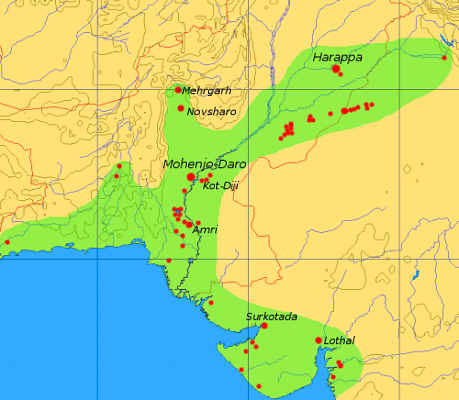
Karel Werner held that "Archaeological discoveries allowed us therefore to speculate with some justification that a wide range of Yoga activities was already known to the people of pre-Aryan India." A seal recently (2008) uncovered in the Cholistan desert was described by Dr. Farzand Masih, Chairman, Archaeology Department, Punjab University, as depicting a "yogi". Thomas McEvilley noted that "The six mysterious Indus Valley seal images...all without exception showed figures in a position known in hatha yoga as mulabhandasana or possibly the closely related utkatasana or baddha konasana...."
Reaction to austere ritualistic religion
From early times, there were those who denied faith in divine beings. Even the Vedic hymns referred sharply to scoffers and unbelievers. Those hymns, usually ascribed to Brihaspati, a son of Loka, put into words the first protests against just a study of the Veda and upheld that a man who tried to soak them up was far superior to the reciting priest. Although there was no special animal fable in Vedic literature, in the Rig-Veda there was all the variety of a story. It pointed to the fondness of the Vedic Aryan for tales of all sorts. There was one song in the Rig-Veda where Brahmins singing at a holy offering were compared to croaking frogs. Prof. Max Muller said that this famous hymn was a satire on Vedic priesthood, or better still, on the manner of hymn chanting. Aitareya Aranyaka put forth, why should we repeat the Vedas or offer this kind of oblation? To offset such negative analyses, the cynics adopted the doctrine of svabhava (nature) as the next stage. This doctrine held that all things were self-existent. They did not create themselves nor any cause created them. For instance, there was no cause for the delicate web of the lotus or the eye-like marks on the peacock's tail. As the cause was not there, they indeed existed on their own. Such was the case with this changing universe. In the same way, feelings like pleasure, pain etc. had no cause, as they were fleeting.
With its claim of pratyaksa or perception as the only means of learning, and physical pleasure being the central object of life, this system was widespread in ancient India. Thus, its name was Lokayata, literally meaning a doctrine spread among the people (loka).
The Vratyas, who were the Aryans from later migrations, came slowly into this belief. Like the Lokayatikas, they too defied everything, including the caste system, sacrifices and the Veda. Drawing upon such generous support, the Lokayatikas exhorted people to strain every nerve for instant earthly welfare rather than striving for a heaven one could not prove existed. Kama or the fulfilment of desire was the central theme of human life. The result of such activity was an urge for freedom—freedom for the individual as well as for society, for the woman as well as for the man, for the poor as well as for the rich. One unique outcome of this struggle for freedom was the rise of the Buddhist culture. Buddha's views against Vedic sacrifices, memorising verses and the fruitless repetition of Vedic mantras, gory ritual of animal sacrifice, the caste system, the authority of the Veda and the worship of the deities and the magic rites, all had counterparts in the views of the Lokayatikas.
Message of the Upanishads
Vedanta was in earlier times a word used in Hindu philosophy as a synonym for that part of the Veda texts known also as the Upanishads. The name was a form of Veda-anta = Veda-end = the appendix to the Vedic hymns. It was inferred that Vedanta stood for the purpose or goal [end] of the Veda. Vedanta was not restricted or confined to one book and there was no sole source for Vedantic philosophy.
Vedic religion gradually evolved into Vedanta, which was viewed by some as the primary institution of Hinduism. Vedanta deemed itself the 'essence' of the Veda.
All forms of Vedanta were drawn primarily from the Upanishads, a set of philosophical and instructive Vedic scriptures. The Upanishads were commentaries on the Veda. They were considered the fundamental essence of all the Veda. Some segment of Vedantic thought was also derived from the earlier aranyakas.
The Aranyakas were called the forest texts, because ascetics retreated into the forest to study the spiritual doctrines with their students, leading to less emphasis on the sacrificial rites that were still performed in the towns. These writings were transitional between the Brahmanas and the Upanishads in that they still discussed rites and had magical content, dull lists of formulas and some hymns from the Veda. The sages who took in students in their forest hermitages were not as wealthy as the priests in the towns who served royalty and other wealthy patrons.
The primary philosophy weighed up in the Upanishads that of one absolute reality termed as Brahman was the main tenet of Vedanta. The sage Vyasa was one of the major proponents of this philosophy and author of the Brahma Sūtras based on the Upanishads. The concept of Brahman – the eternal, self-existent, immanent and transcendent Supreme and Ultimate Reality which was the divine view of all being - was central to most schools of Vedānta. The notion of God or Ishvara was also there. Vedantic sub-schools differed mainly in how they would identify God with Brahman.
The Upanishads were works of various authors living in different ages. They were the words of spiritual-minded people, who got glimpses of the highest truth by observation and were not necessarily part of a consistent system of philosophy. Their ways were intuitive rather than logical and they dealt with topics like God, man, destiny, soul etc. There were so many hints, suggestions and implications in the Upanishads and so varied that subsequent founders of almost all religions and religious sects in India had been able to quote one or more of these as authority.
In spite of the brilliance of such ideas, they were not adequate for the religious needs of the people. Their appeal lay with the intelligentsia, not with the ordinary man to whom attainment of such profound knowledge appeared a distant dream. Upanishadic philosophers soared to dizzy heights and laid the basis on which Indian thoughts were to be refined in later years.
India stirred up with freethinking views and the Buddha was the result of this freedom. No man ever lived such a godlike life, without ever talking of a god. The Vishnu Purana had a record of this stage of the school. It alluded to a set of people of very ancient origin who were free to live wherever they liked, unworried by conventions, pure at heart and blameless in action. Virtue or vice they had none; they lived in an ambience of perfect freedom in which men could move without fear of disobeying traditional dogmas of religious and social usage. Still, the ordinary devoted followers were not satisfied merely with social and religious freedom. As the Lokayatikas captured the hearts of the cultured as well as the common people, all were set on working out their immediate earthly welfare.
Before proceeding further on the topic it is necessary to recall certain basic tenets touched upon so far with a view to link with development of a few major religions in India during the coming centuries.
The Upanishads were like a breath of fresh air blowing through the stuffy corridors of power of the Vedic Brahmanism. They were noticed by the priestly authorities because the yogis did not owe allegiance to any established religion or mode of thought. They were very largely saying what may well have been current among other sramanic groups at that time. Such an atheistic doctrine was evidently very acceptable to the authors of Upanishads, who made use of many of its concepts.
The end of the Vedantic period was around the 2nd century CE. In the latter period, several texts were composed as summaries/attachments to the Upanishads. These texts collectively called as Puranas allowed for a divine and mythical interpretation of the world, not unlike the ancient Hellenic or Roman religions. Legends and epics with a multitude of gods and goddesses with human-like characteristics were composed. Two of Hinduism's most revered epics, the Mahabharata and the Ramayana were compositions of this period. Devotion to particular deities was reflected from the composition of texts composed to their worship. For example, the Ganapati Purana was written for devotion to Ganapati (or Ganesha). Popular deities of this era were Shiva, Vishnu, Durga, Surya, Skanda, and Ganesh (including the forms/incarnations of these deities.)
Unlike the early Vedic religion neither the Brahmanic rituals nor the spiritualism of the Upanishads could somehow become popular. A religion, in order that it might become popular, needed a simple and uniform creed, a good deal of mythology, certain easy practices of worship. The failure of the Vedic Brahmanas and the Upanishads in this respect resulted in an indirect support to the non-Vedic religious thought. Non-Vedic religious systems such as Buddhism and Jainism quickly spread. They adopted the mythology, worship of the deities and intelligent speculation of a variety of Upanishads. At the same time they steered clear of the weak points in them.
Shramana tradition
Vedic religion of Iron Age India co-existed and closely interacted with the parallel non-Vedic shramana traditions. These were not direct outgrowths of Vedism, but separate movements that influenced it and were influenced by it. The shramanas were wandering ascetics. Buddhism and Jainism were a continuation of the shramana custom, and the early Upanishadic movement was influenced by it.
As a rule, a shramana was one who renounced the world and led an ascetic life for the purpose of spiritual development and liberation. They asserted that human beings were responsible for their own deeds and reaped the fruits of those deeds, for good or ill. Liberation from such anxiety could be achieved by anybody irrespective of caste, creed, colour or culture. Yoga was probably the most important shramana practice to date. Elaborate processes were outlined in Yoga to achieve individual liberation through breathing techniques (Pranayama), physical postures (Asanas) and meditation (Dhyana).
The movement later received a boost during the times of Mahavira and Buddha when Vedic ritualism had become the dominant belief in certain parts of India. Shramanas adopted a path alternate to the Vedic rituals to achieve liberation, while renouncing household life. They typically engaged in three types of activities: austerities, meditation, and associated theories (or views). At times, a shramana was at variance with traditional authority, and he often recruited members from priestly communities as well. Mahāvīra, the 24th Jina, and Gautama Buddha were leaders of their shramana orders. According to Jain literature and the Buddhist Pali Canon, there were also some other shramana leaders at that time.
Indian philosophy was a confluence of shramanic (self-reliant) traditions, Bhakti traditions with idol worship and Vedic ritualistic nature worship. These co-existed and influenced each other. Śramanas held a view of samsara as full of suffering (or dukkha). They practiced Ahimsa and rigorous ascetism. They believed in Karma and Moksa and viewed re-birth as undesirable.
Vedics, on the contrary, believed in the efficacy of rituals and sacrifices, performed by a privileged group of people, who could improve their life by pleasing certain gods. The Sramanic ideal of mendicancy and renunciation, that the worldly life was full of suffering and that emancipation required abandoning desires and withdrawal into a solitary contemplative life, was in stark contrast with the Brahminical ideal of an active and ritually punctuated life. Traditional Vedic belief held that a man was born with an obligation to study the Vedas, to procreate and bring up male offspring and to perform sacrifices. Only in later life would he meditate on the mysteries of life. The idea of devoting one's whole life to mendicancy seemed to disparage the whole process of Vedic social life and obligations. Because the shramanas rejected the Vedas, the Vedics labelled their philosophy as "nastika darsana" (heterodox philosophy).
Astika and nastika were sometimes used to categorise Indian religions. Those religions that believed that God was the central actor in this world were termed as astika. Those religions that did not believe that God was the prime mover were classified as nastika. From this point of view the Vedic religion (and Hinduism) was an astika religion, whereas Buddhism and Jainism were nastika religions.
Note: This article contains text passages from various Wikipedia articles on the subject, copied under the Creative Commons Share Alike license.
